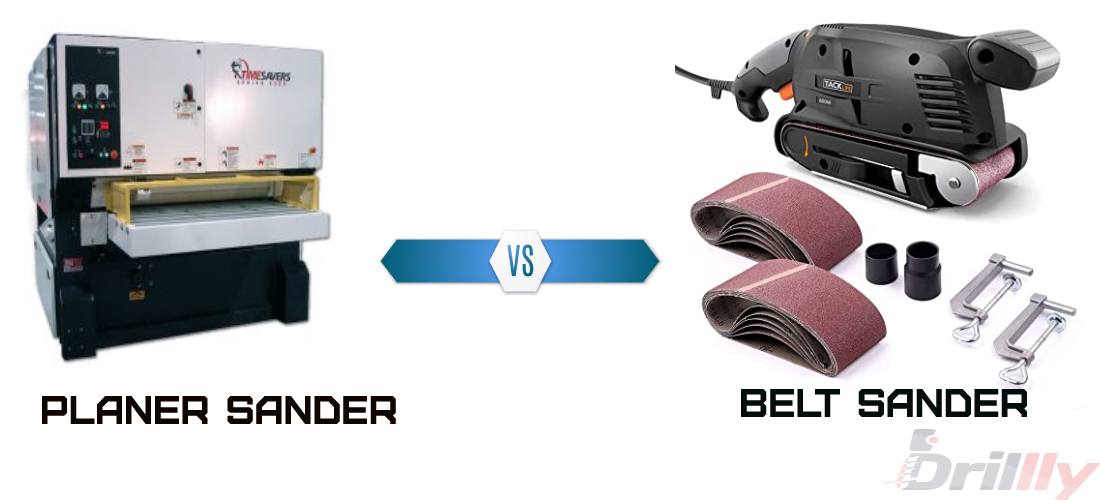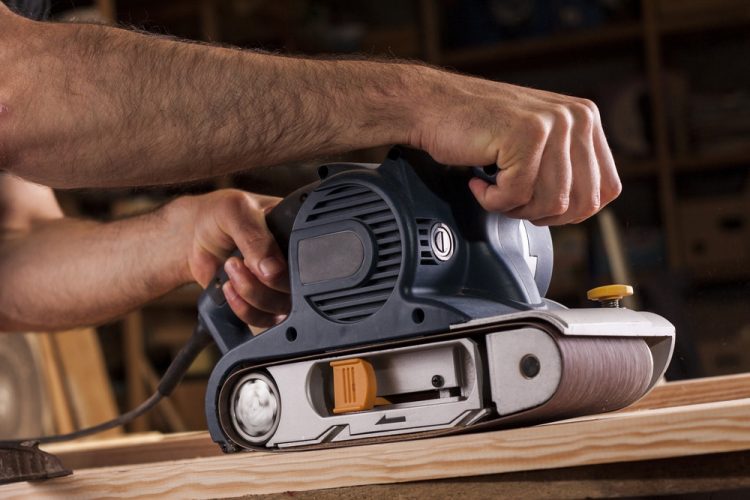Planer or Belt sanders? This has become a common problem when you’re involved with the removal of slice wood and vanishes from wood surfaces.
One misconception from beginners is the assumption that the tools carry out similar functions. But this is not true. Are you at a crossroads of choosing a wood planer and a belt sander?
This is an intensive guide to learn more about the differences and benefits of both tools.
Belt Sander vs Planer: The Key Differences

What is a Belt Sander?
A belt sander seems as though the most effective tool in a woodworking set. Its primary function is removing frailties from a surface like drywall wood.
Taken to be a phenomenal tool to have at your disposal, a sander is essential in refinishing a wood piece, to fixing irregular stains or deterioration that occurs on wood over time. Equipped with a motor that powers a loop of mounted sandpaper, it is specially designed to get a job done in a short time frame.
Once you have the needed experience, the belt sander becomes relatively easy to use, although it also comes with a lot of power under the hood.
A top-notch belt sander is quite aggressive, and if not handled properly, it could lead to excessive removal of material. As a result, leading to more waste of time when trying to make a perfect footing.
A couple of benefits when using a belt sander:
- Efficient and Quick: Ahead others, a belt sander is designed to help undertake big projects much quicker than you could imagine; this reason makes the tool complicated for most beginners. Due to the power it supplies, special attention has to be given on how much substance is removed from a single swipe. Nonetheless, with an idea of how this tool works, it can easily be user-friendly.
- Broad Surface: Generally, there are several sizes of belt sanders that you can select from, but we suggest that you opt for varieties that are designed with a large surface area since it can help prevent going over the same spot twice. This ensures few or no imperfections.
- Develops expertise: Another delightful benefit of a belt sander is that it encourages a skill that you might not learn using other tools. As with only a few pieces of equipment, there is a learning curve to tackle, and once you get your hands on a belt sander, you’ll learn more about the importance of balancing tools.
Belt Sander: Pros & Cons
Pros
- The durability of materials and high-grade engineering
- Ergonomically designed with a front and rear handle layout
- Created with an 11 Amp motor that has a velocity control technology
- Ease of changing sanding pads
- Augmented sanding belt created for optimal efficiency
- Compactable with most wide paper grits.
- Sound level reduction
- 3600 adjustable dust bag
Cons
- High cost.
- No variable speed management.
What is a Planer?
A planer would be vital if the task at hand involves surface leveling. Planers are explicitly created to remove slices of wood on every pass. When compared to belt sanders that are known to finish a woodwork project, planers tend to be more effective.
It’s essential to have a planer depending on the project you’re faced with since you can easily carry out large and small adjustments comfortably, especially when the project is carried out on doors, shelves, and cupboards.
Take this scenario as an instant; if the door to your bedroom is a bit bigger than its frame, a hand planer can be used to make the necessary adjustments on the length or width of the wooden frame. We suggest investing in a planer since it’s user-friendly and easy to control.
Below are some upsides of using a planer or a belt sander:
- Uniformity: this is one of the tremendous advantages of a planer tool. It’s much easier to create consistent and straight cuts with each pass. If you’re not experienced with handling the belt sander, you may spot out lots of high and shallow spots on the wood surface, and this results from how the tool was held. While using a planer, it is still possible not to attain uniformity on a wood surface.
- Cost-Effective: The tendency of the tool being a life-time investment is another advantage it has over the belt sander aside from blade sharpening and replacement accountable for acquiring replacement sandpaper. Most professionals prefer not being bugged about buying extra accessories to keep their tools running.
- Even and Smooth Finishes: Using a planer gives room for even and smooth finishes at the end of each pass. Unfortunately, some people still experience gritty feelings on the wood surface after using belt sanders. To get a perfect even and flat surface, considering planers will be the most suitable option.
Planer: Pros & Cons
Pros
- Comprehensive knife life owing to the premium-quality head cutter.
- Effortlessly cut through wide materials.
- It comes with knives for replacement.
- High experience is needed.
Cons
- Noise level issues
- High cost
Planer vs. Belt Sander – What to Choose?
Choosing between a belt and a planer tool is pretty easy as long as you know what the project or task at hand demands. Both the belt and planer sander are great tools when used specifically for what they are meant to accomplish. We strongly recommend having both as the essential woodworking tools within your arsenal.
FAQ
Q. 1: What is the best belt sander?
Ans: Below is a shortlist of the top belt sanders:
a) First Choice: TACKLIFE PSFS1A
b) Most Versatile Choice: Wen 6500
c) Budget Choice: Skil 7510-01 Sandcat
Q. 2: Why do you need a wood planer?
Ans: The thickness planer is used for three different purposes –
a) It makes a face board parallel when compared to other faces
b) It helps smooth up ragged stock
c) It decreases stock down to the precise thickness
Q. 3: What is a wide belt sander?
Ans: Wide belt sanders are mainly used on composite boards and solid wood like MDF and plywood. The stock is carried by a rubber conveyor, while the wider belt made of abrasive takes off the materials from the surface.
Q. 4. What can you use a belt sander for?
Ans: Strip or belt sanders are used to shape and finish wood projects. They have an electrical device that helps rotate sets of drums within a loop of sandpaper.








